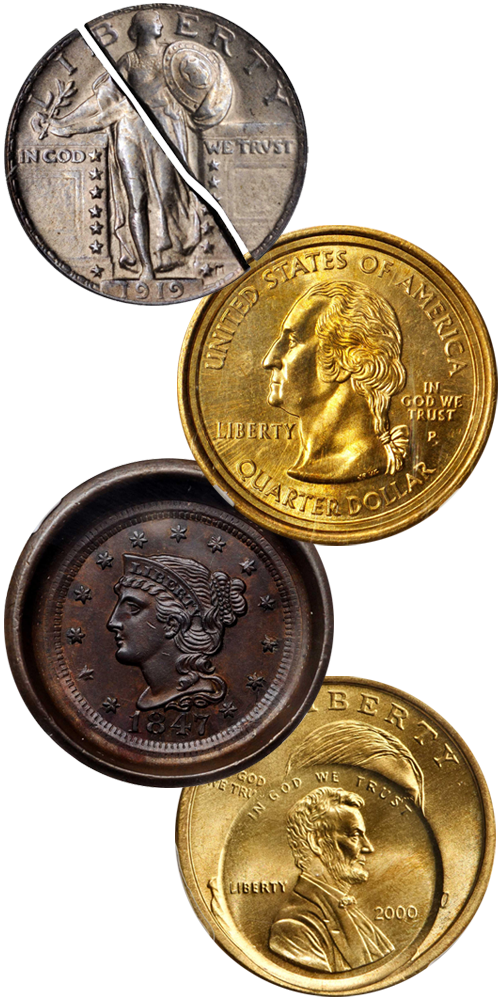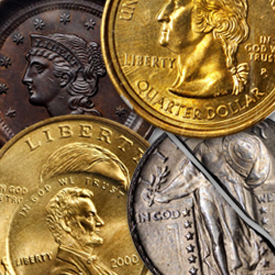While the overwhelming majority of U.S. Mint’s output is free of defects, on rare occasions defective coins are made and a few of these manage to escape into circulation for a brief time. Because the minting process is complex and involves many steps, quite a few things can go wrong, from defects in the planchets and dies, to the striking of the coins. The Guidebook of United States Coins breaks error coins into nine different types.
1. Clipped Planchet – these typically appear as a circular “bite” taken out from an edge of a coin though other shapes and patterns are seen. Usually a coin has only one portion out, but sometimes more than one clip is seen.
2. Multiple Strike – occurs when a coin already struck, is struck again with an off-center image. Values vary depending on the number of strikes and whether a date is showing as well as the age and denomination.
3. Blank Planchet – Prior to striking, circular discs of metal, or planchets are fed into the presses. If a planchet failed to be struck by the coining dies, it is simply blank. Variations include pieces with, and without finished or milled rims. Because they are blank, no “type” is known, only the denomination and metal.
4. Defective or Cracked Die – A coining die leads a tough life, striking thousands of planchets at high speed and pressure. After much use, they can develop cracks which result in a raised portion of metal on the finished coin. In extreme cases, a part of the die breaks away which results in an unstruck area, called a “cud.”
5. Off Center – A coin struck out of its collar and its design shifted partially off the planchet is off center, and is among the more desirable errors. The value is naturally dependent if a date is showing, how off center the coin is, and of course the denomination and type.
6. Broadstrike – A broadstrike is similar to an off-center strike in that both were struck outside of the retaining collar. However, a broadstrike is basically centered, but simply spread out to a slightly larger diameter as no collar was present. All have plain edges.
7. Lamination ¬– A lamination is cause by some foreign substance such as gas oxides or dirt becoming imbedded in the metal strip as it is being rolled into the proper thickness. This causes a flake or portion of the surface to peel away leaving a gouge or depression in the field or device. Sometimes the peeled surface is still attached to the coin, and in these cases, the coin cannot be sealed by the grading services. Laminations can be of varying size and severity.
8. Brockage – When a struck coin remains “stuck” inside the die, the next few coins struck by that die bear the mirror image of the coin inside the die. Because the imbedded coin is in “positive” relief, the brockage exhibits a negative or sunken image after being struck.
9. Wrong Planchet or Metal – These are the “kings” of errors, and include such exotic known pieces as a Walking Liberty Half struck on a dime planchet, a Sacagawea dollar struck on a cent planchet, and a Washington Quarter struck on a steel cent planchet! Also included in this category are the 1943 cents struck in copper and the 1944 steel cents. These are technically errors even though they look quite “normal” and may have circulated for a short time before being noticed.
In this category as well are “mules” with the obverse of one design and the reverse of another. These errors are extremely rare and highly sought after by collectors.
Errors remain one of the more visually interesting and unusual areas of numismatics, especially to non-collectors who are often amazed to see an off-center or multiple strike coin for the first time.







